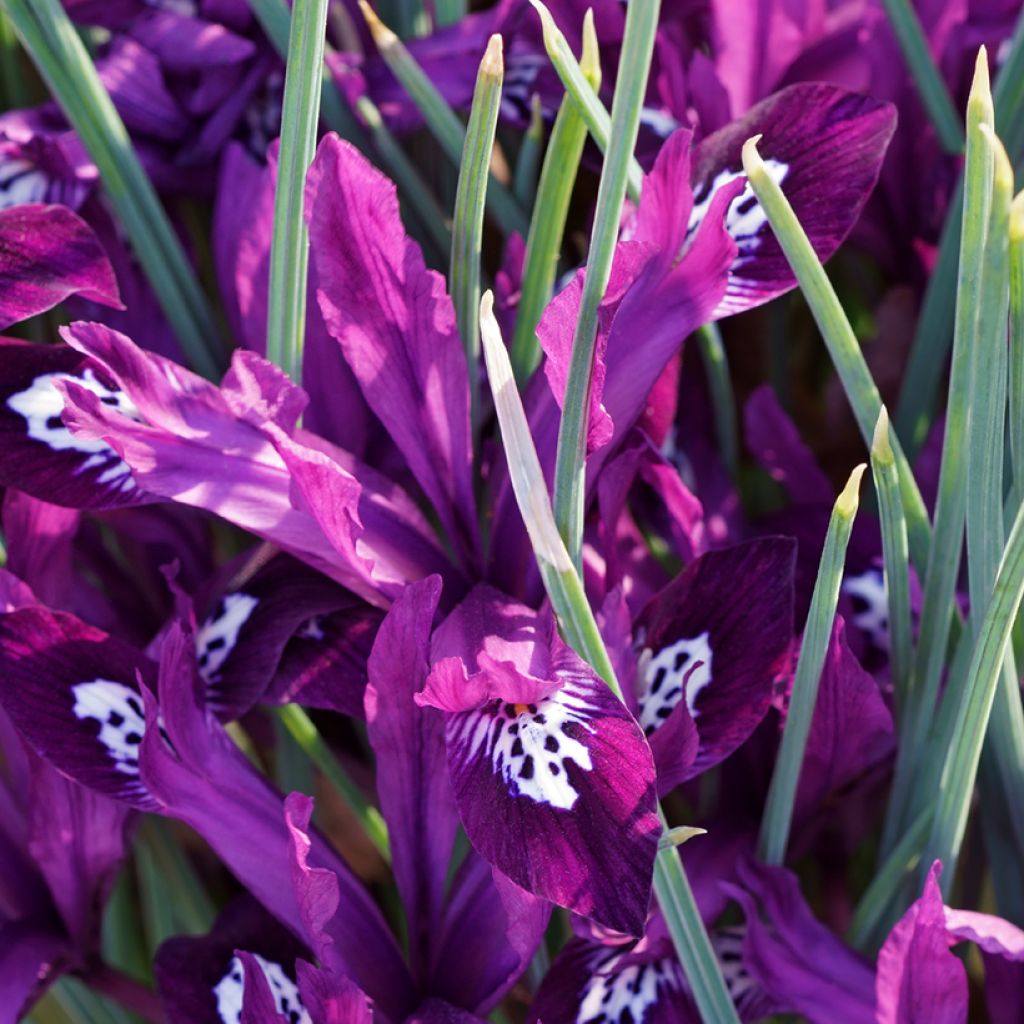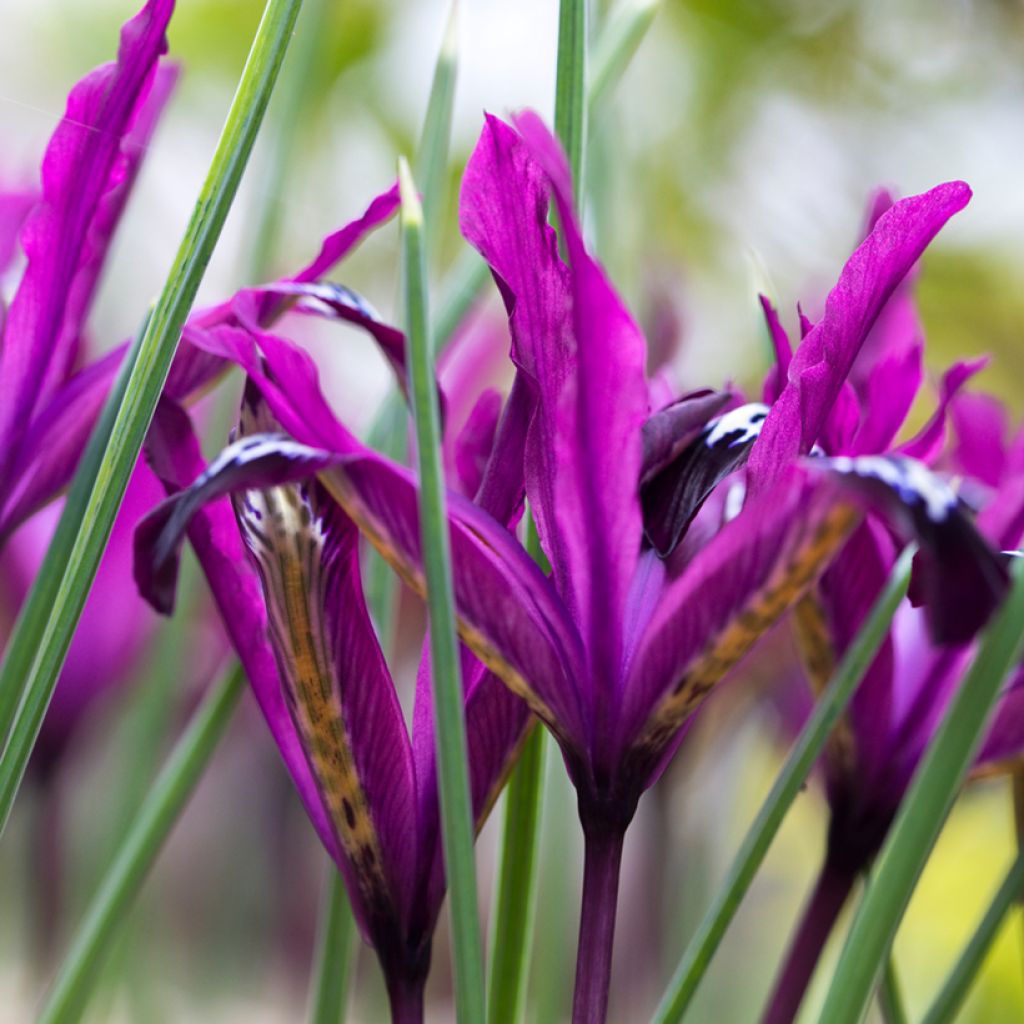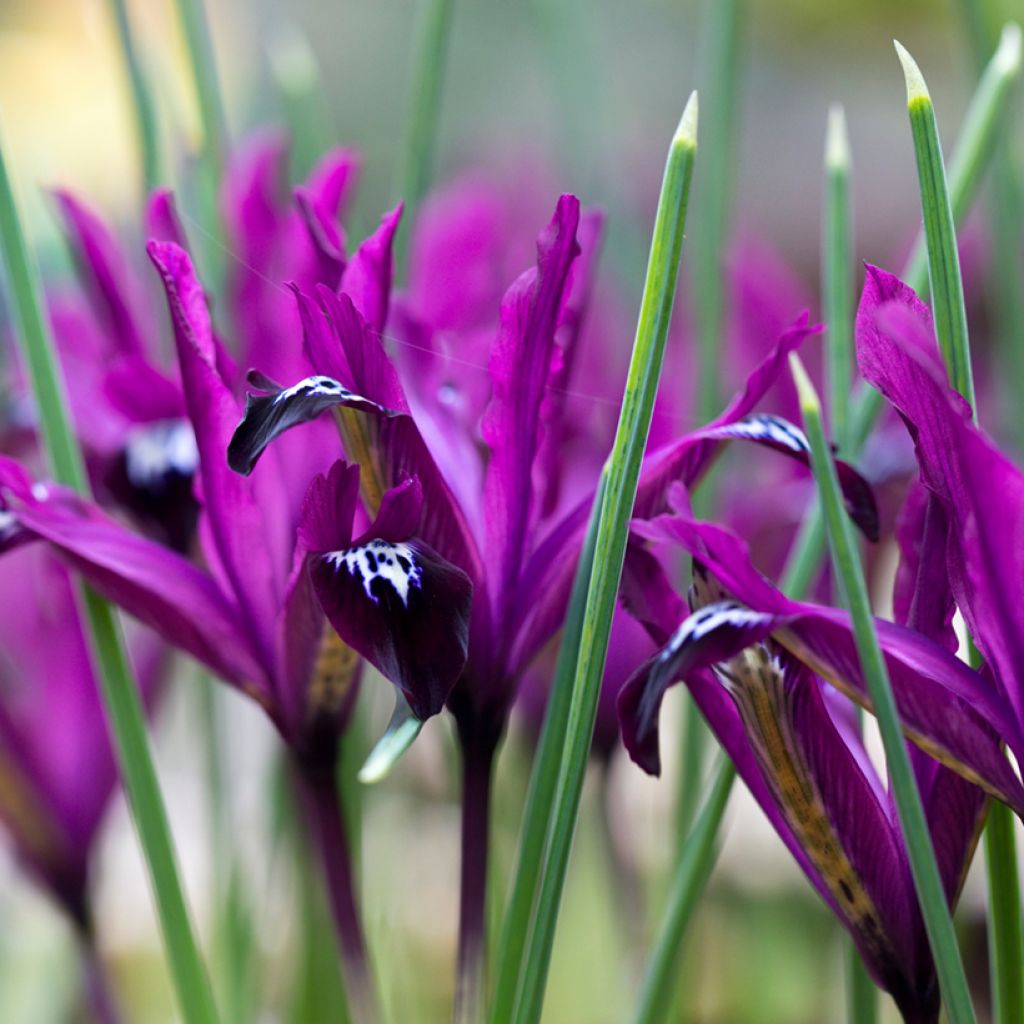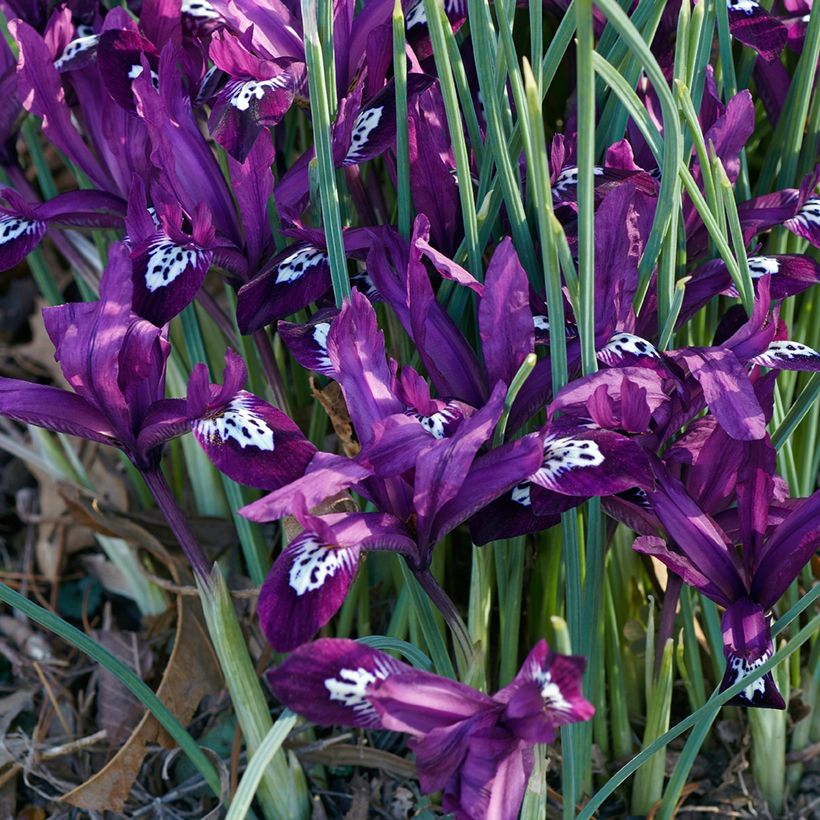

Iris reticulata Pauline


Iris reticulata Pauline


Iris reticulata Pauline
Iris reticulata Pauline
Iris reticulata Pauline
Reticulated Iris, Netted Iris
This plant carries a 6 months recovery warranty
More information
We guarantee the quality of our plants for a full growing cycle, and will replace at our expense any plant that fails to recover under normal climatic and planting conditions.
From €5.90 for pickup delivery and €6.90 for home delivery
Express home delivery from €8.90.
Does this plant fit my garden?
Set up your Plantfit profile →
Description
Iris reticulata 'Pauline' is an attractive cultivar of iris known for its contrast and rich colour. It produces dark, violet-purple flowers with enticing white and ink-blue spots on the lips from late winter. It is slender and upright, graceful, with flowers barely touched by yellow and develops grey-green foliage. This small bulblet is sturdy despite its delicate appearance, perfectly hardy and blooms in February-March, adapting well to mountain or Mediterranean climates. A very pretty rock garden and container plant which should be planted in well-drained soil.
Iris reticulata is a perennial plant of the iridaceae family, native to the mountains of the Caucasus, Turkey, Iran, and Iraq. This iris is very hardy (down to -34°C) and easy to grow in well-drained soil. 'Pauline' is a hybrid derived from this species. The plant grows from a storage organ, which is an elongated bulb 2 to 3 cm tall, covered with a white skin. It blooms from late February, or in March depending on the climate, before the foliage appears, making it valuable in the garden. The 8 to 10 cm wide flowers are borne on stems about 12 cm tall. They are large compared to the size of the plant and seem to emerge directly from the ground. They consist of 3 upright inner tepals dominating 3 more horizontal outer tepals. They are slightly fragrant. The foliage develops when the flowers fade, forming a clump of narrow, stiff, pointed leaves, up to 20 cm tall. At this time the bulb divides into several bulblets, allowing the plant to colonise its environment.
Iris reticulata 'Pauline' adapts perfectly to pot culture, sunny borders, or rock gardens. This plant's main requirements are well-drained soil and exposure to sunlight. It blends beautifully with other small spring bulbs such as snowdrops, chionodoxas, crocuses, or early and botanical tulips. It also looks lovely in front of Stern hellebores that appreciate the sun, and it is recommended to plant it in groups of 15 bulbs alongside Pulsatilla patens, for example. This plant is also well-suited for alpine trough culture, where it can coexist with species like Dodecatheon, Globularia cordifolia, or Saxifraga 'Pixie'.
Report an error about the product description
Iris reticulata Pauline in pictures


Plant habit
Flowering
Foliage
Botanical data
Iris
reticulata
Pauline
Iridaceae
Reticulated Iris, Netted Iris
Cultivar or hybrid
Planting and care
Plant the bulbs of the Pauline Iris in September-October, in a sunny location, in well-drained soil, at a depth of 10 cm, preferably in groups, spaced 8 cm apart. Cut the faded flowers at their base, taking care to leave the stem. Continue to water the plants at their base. Once the foliage has turned yellow, remove it and leave the bulbs in place for them to flower again the following year. After flowering, water three times with liquid fertiliser at one-month intervals. Leave the bulbs in place for several years.
Planting period
Intended location
Care
This item has not been reviewed yet - be the first to leave a review about it.
Haven't found what you were looking for?
Hardiness is the lowest winter temperature a plant can endure without suffering serious damage or even dying. However, hardiness is affected by location (a sheltered area, such as a patio), protection (winter cover) and soil type (hardiness is improved by well-drained soil).

Photo Sharing Terms & Conditions
In order to encourage gardeners to interact and share their experiences, Promesse de fleurs offers various media enabling content to be uploaded onto its Site - in particular via the ‘Photo sharing’ module.
The User agrees to refrain from:
- Posting any content that is illegal, prejudicial, insulting, racist, inciteful to hatred, revisionist, contrary to public decency, that infringes on privacy or on the privacy rights of third parties, in particular the publicity rights of persons and goods, intellectual property rights, or the right to privacy.
- Submitting content on behalf of a third party;
- Impersonate the identity of a third party and/or publish any personal information about a third party;
In general, the User undertakes to refrain from any unethical behaviour.
All Content (in particular text, comments, files, images, photos, videos, creative works, etc.), which may be subject to property or intellectual property rights, image or other private rights, shall remain the property of the User, subject to the limited rights granted by the terms of the licence granted by Promesse de fleurs as stated below. Users are at liberty to publish or not to publish such Content on the Site, notably via the ‘Photo Sharing’ facility, and accept that this Content shall be made public and freely accessible, notably on the Internet.
Users further acknowledge, undertake to have ,and guarantee that they hold all necessary rights and permissions to publish such material on the Site, in particular with regard to the legislation in force pertaining to any privacy, property, intellectual property, image, or contractual rights, or rights of any other nature. By publishing such Content on the Site, Users acknowledge accepting full liability as publishers of the Content within the meaning of the law, and grant Promesse de fleurs, free of charge, an inclusive, worldwide licence for the said Content for the entire duration of its publication, including all reproduction, representation, up/downloading, displaying, performing, transmission, and storage rights.
Users also grant permission for their name to be linked to the Content and accept that this link may not always be made available.
By engaging in posting material, Users consent to their Content becoming automatically accessible on the Internet, in particular on other sites and/or blogs and/or web pages of the Promesse de fleurs site, including in particular social pages and the Promesse de fleurs catalogue.
Users may secure the removal of entrusted content free of charge by issuing a simple request via our contact form.
The flowering period indicated on our website applies to countries and regions located in USDA zone 8 (France, the United Kingdom, Ireland, the Netherlands, etc.)
It will vary according to where you live:
- In zones 9 to 10 (Italy, Spain, Greece, etc.), flowering will occur about 2 to 4 weeks earlier.
- In zones 6 to 7 (Germany, Poland, Slovenia, and lower mountainous regions), flowering will be delayed by 2 to 3 weeks.
- In zone 5 (Central Europe, Scandinavia), blooming will be delayed by 3 to 5 weeks.
In temperate climates, pruning of spring-flowering shrubs (forsythia, spireas, etc.) should be done just after flowering.
Pruning of summer-flowering shrubs (Indian Lilac, Perovskia, etc.) can be done in winter or spring.
In cold regions as well as with frost-sensitive plants, avoid pruning too early when severe frosts may still occur.
The planting period indicated on our website applies to countries and regions located in USDA zone 8 (France, United Kingdom, Ireland, Netherlands).
It will vary according to where you live:
- In Mediterranean zones (Marseille, Madrid, Milan, etc.), autumn and winter are the best planting periods.
- In continental zones (Strasbourg, Munich, Vienna, etc.), delay planting by 2 to 3 weeks in spring and bring it forward by 2 to 4 weeks in autumn.
- In mountainous regions (the Alps, Pyrenees, Carpathians, etc.), it is best to plant in late spring (May-June) or late summer (August-September).
The harvesting period indicated on our website applies to countries and regions in USDA zone 8 (France, England, Ireland, the Netherlands).
In colder areas (Scandinavia, Poland, Austria...) fruit and vegetable harvests are likely to be delayed by 3-4 weeks.
In warmer areas (Italy, Spain, Greece, etc.), harvesting will probably take place earlier, depending on weather conditions.
The sowing periods indicated on our website apply to countries and regions within USDA Zone 8 (France, UK, Ireland, Netherlands).
In colder areas (Scandinavia, Poland, Austria...), delay any outdoor sowing by 3-4 weeks, or sow under glass.
In warmer climes (Italy, Spain, Greece, etc.), bring outdoor sowing forward by a few weeks.


































